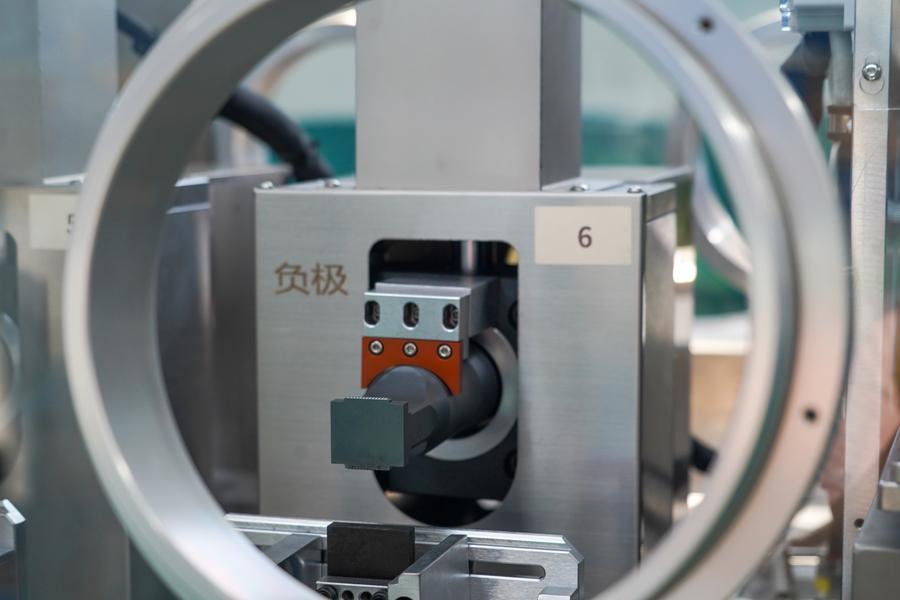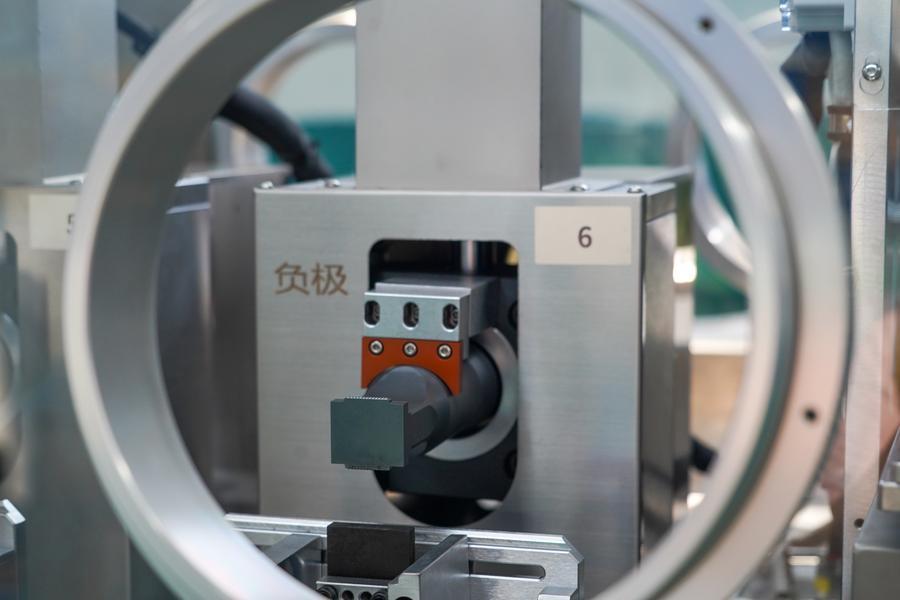
This photo taken on Sept. 2, 2024 shows part of a solid-state lithium metal battery in Yibin, southwest China's Sichuan Province. (Xinhua/Tang Wenhao)
BEIJING, March 12 (Xinhua) -- The market attention on solid-state batteries has been on the rise recently as the 2025 all-solid-state battery technology exchange conference is about to be convened in Bengbu, east China's Anhui Province on March 18 to 19, and BEIJING-HYUNDAI AUTO announced to launch a pilot production line for all-solid-state batteries in March.
The global solid-state battery market size is expected to exceed 200 billion yuan by 2030, according to Gaogong Industry Institute (GGII).
-- Market demand drives scale growth
At present, the main technological routes for solid-state batteries worldwide can be divided into three categories, namely oxides, sulfides, and polymers, with each route boasting different performance advantages and facing different challenges, said Zhang Jiafeng, a professor at the School of Metallurgy and Environment with Central South University, adding that domestic listed companies mainly focus on technological routes of oxides and sulfides.
According to Zhang, oxide solid-state batteries have excellent stability, adaptability to high-voltage positive electrode materials, and low manufacturing costs, but their poor interface contact leads to short cycle life and low room-temperature conductivity, requiring the addition of liquid electrolytes or conductive polymers to improve performance. Ganfeng Lithium Group Co., Ltd. (Ganfeng Lithium, 002460.SZ, 01772.HK) is a typical representative in terms of such technological route, he added.
The advantages of sulfide solid-state batteries are the highest ionic conductivity, high energy density potential, and adaptability to all-solid-state systems, while the disadvantages are poor chemical stability and high manufacturing costs, Zhang stated, noting that EVE Energy Co., Ltd. (EVE Energy, 300014.SZ) and Huawei Technologies Co., Ltd. (Huawei Technologies) have made layouts in this technological route.
Some listed companies have simultaneously laid out multiple technological routes, including Contemporary Amperex Technology Co., Limited (CATL, 300750.SZ), BYD Company Limited (BYD, 01211.HK, 002594.SZ), Gotion High-tech Co., Ltd. (Gotion High-tech, 002074.SZ), etc., Zhang noted.
According to a survey report released by Japanese market research agency FujiEconomy, the global market size of all-solid-state batteries is estimated to reach about 5.419 billion yuan in 2024, which is four times that of 2023, and to expand to about 407.351 billion yuan in 2045, which will reach 299.2 times that of 2023.
Behind this exponential growth in the market size is the strong drive of dual demands, said Zhang Jiafeng, noting that new energy vehicles are facing a bottleneck in range after the market penetration exceeds 36 percent, and meanwhile, the explosive growth of humanoid robots has raised rigid demands for high-safety and high-energy-density batteries.
-- Competition among A-share listed companies heats up
As the market space for solid-state batteries is vast, the competition among listed companies continues to heat up.
Leading enterprises have strengthened related layouts with core technological advantages. For instance, CATL has increased investment in the research and development (R&D) of all-solid-state batteries, expanded the R&D team to over 1,000 people, and plans to produce solid-state batteries in small batches by 2027.
BYD has adopted a staggered stacking design to improve the performance of the all-solid-state batteries developed by the company with a range of up to 1,200 kilometers. Gotion High-tech has successfully developed an all-solid-state battery which follows the norms and standards of the automotive industry and adopts micro-nano solid electrolytes, ultra-thin film coated single crystal positive electrodes and the three-dimensional mesoporous silicon negative electrode material technology, with a single-charge range of up to 1,000 kilometers.
Driven by leading companies, industrial chain enterprises have also joined the commercialization process of solid-state batteries.
The demand for negative electrode materials varies among different technological routes of solid-state batteries, and negative electrode materials including silicon-carbon negative electrodes and lithium metal negative electrodes can all be applied in solid-state batteries, said Lu Yan, a senior manager with Hunan Zhongke Electric Co., Ltd. (Zhongke Electric, 300035.SZ).
Zhongke Electric has currently made development and product layouts in areas such as silicon-carbon negative electrodes and lithium metal negative electrodes for different technological routes of solid-state batteries, with a pilot production line for silicon-carbon negative electrodes completed and some products entering the stages of customer evaluation and platform development, according to Lu.
In addition, a number of listed companies have announced the progress related to solid-state batteries on investor interaction platforms. For example, Hunan Yuneng New Energy Battery Material Co., Ltd. (301358.SZ) has produced lithium iron phosphate, lithium manganese iron phosphate, and ternary products which can be used as positive electrode materials for solid-state batteries, and actively connected with downstream solid-state battery manufacturers.
Sanxiang Advanced Materials Co., Ltd. (603663.SH) has established production capacity advantages, technological advantages, and cost advantages in zirconium-based products, and carried out business cooperation with some solid-state battery enterprises. Shanghai Emperor of Cleaning Hi-Tech Co., Ltd. (603200.SZ) has reserved other solid electrolyte powder technology routes for sulfides, chlorides and other solid electrolytes.
As the key moment of industrialization of solid-state batteries approaches, the market landscape of the global new energy vehicle and robot industries may be reshaped.
In the view of Zhang Jiafeng, the essence of competition in solid-state batteries is the competition of manufacturing systems, and with the dual support of industry and capital, the commercialization process has accelerated.
In this competition that will determine the energy landscape of the next decade, the choice of technological routes and the collaborative ability of the industrial chain will become key factors for enterprises to develop solid-state batteries, according to Zhang.
(Edited by Gu Shanshan with Xinhua Silk Road, gushanshan.1987@163.com)




 A single purchase
A single purchase









